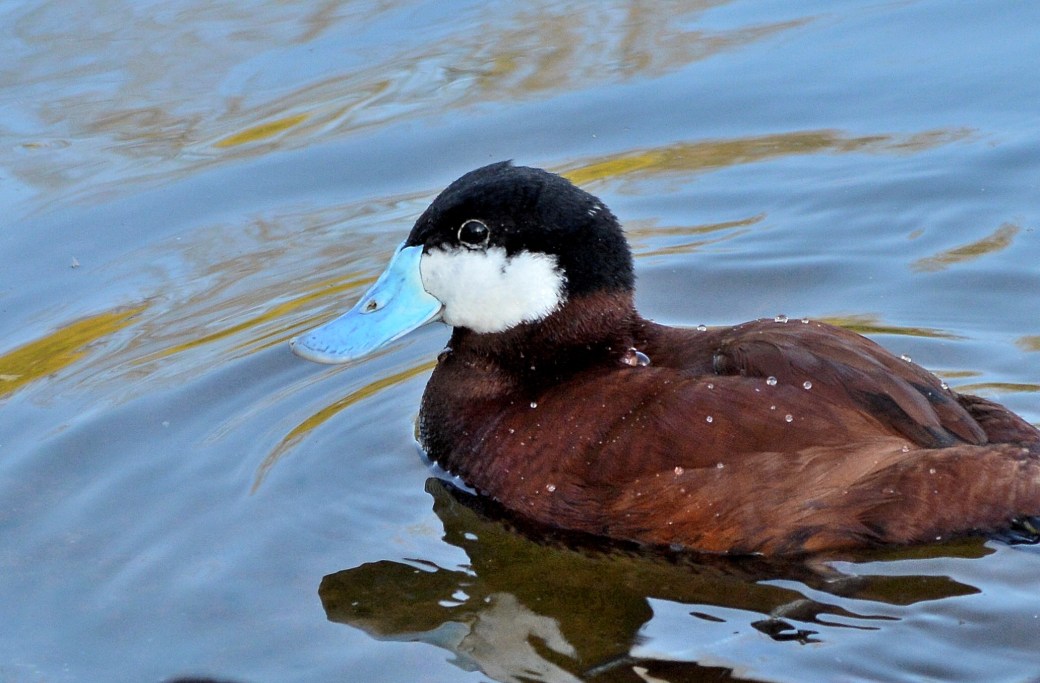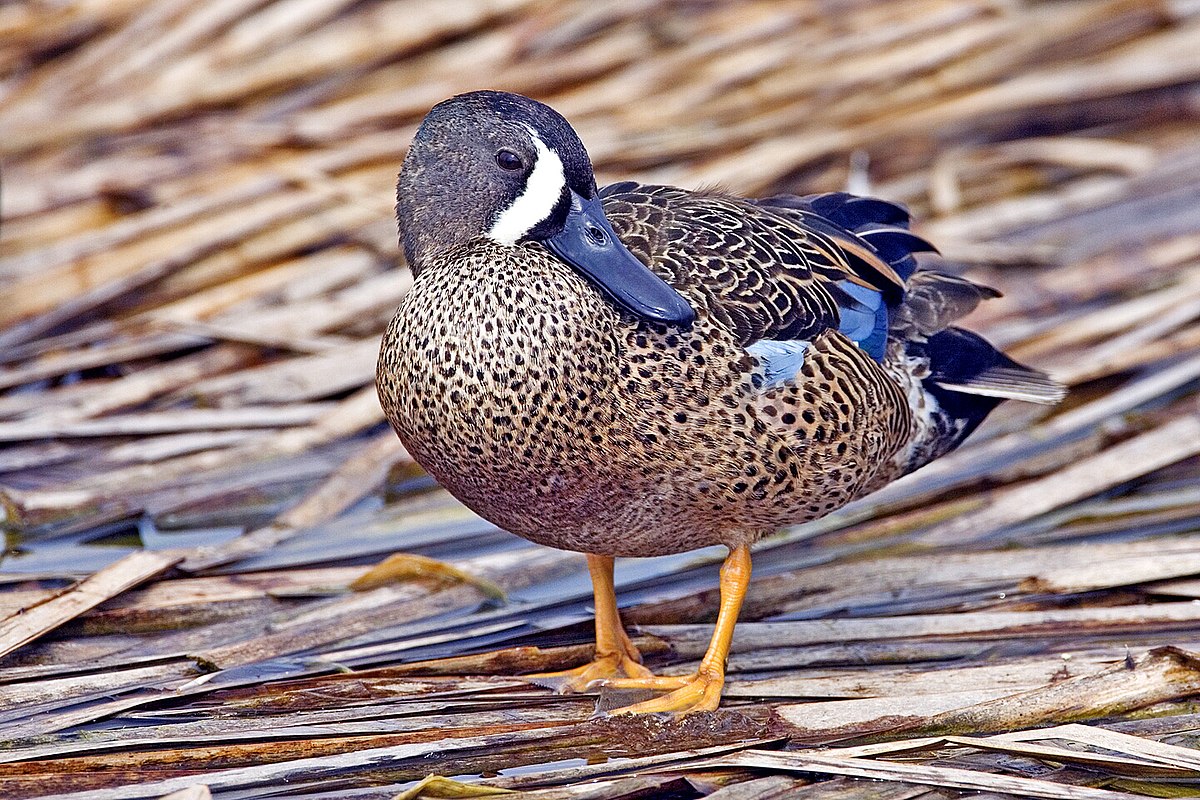The blue-billed or Hottentot teal, scientific name Spatula hottentota is a species of dabbling duck of the genus Spatula.
Blue-Billed Teal Profile
It is a migratory resident in eastern and southern Africa, from Sudan and Ethiopia west to Niger and Nigeria and south to South Africa and Namibia. In west Africa and Madagascar, it’s sedentary.
Blue-billed teals are small, inconspicuous, sexually dimorphic geese. While each sex has a blue beak and green streaks by their wings, solely females have spotted flanks.
Blue-billed teals travel in both single pairs or fluid teams. They construct giant, raised nests with grasses, leaves, and red stems.
Males and females pair in the course of the breeding season however often separate after the feminine’s incubation interval. Chicks are born with a darkish brown back, a tan stomach, and a grey bill and legs.
The blue-billed teal breeds year-round, relying on rainfall, and stays in small teams or pairs. They construct nests above water in tree stumps and use vegetation.
Ducklings depart the nest quickly after hatching, and the mom’s parenting is proscribed to offering safety from predators and main younger to feeding areas. This species is omnivorous and prefers smaller shallow bodies of water.
The blue-billed teal is among the species to which the Agreement on the Conservation of African-Eurasian Migratory Waterbirds (AEWA) applies. The standing of the blue-billed teal on the IUCN Red List as Least Concern.
Several authorities nonetheless discuss this species because of the Hottentot teal, nevertheless, because the phrase “Hottentot” is an offensive time period for the Khoisan people, there was a motion to vary the vernacular name.
Blue-Billed Teal Distribution and habitat
The range of the blue-billed teal extends in Africa from Angola, Zambia, eastern Congo, Malawi, northern Mozambique, Tanzania, Kenya, Uganda, southern Ethiopia, Sudan, and Madagascar.
They are primarily present in tropical eastern Africa: Ethiopia to Cape Province, westward to northern Botswana and Namibia, and Madagascar.
The blue-billed teal prefers habitats with ample floating-leaf vegetation and fringe vegetations, together with shallow fresh-water swamps, marshes, streams, shallow small lakes, and ponds with fringed edges of reeds or papyrus.
They are noticed to spend the twilight and night hours dabbling in very shallow waters and move to deeper and safer components of the marsh in the course of the daytime.
Blue-Billed Teal Description
Adult males have darkish brown crown contrasting with paler face, throat, breast, and side aside from a blackish thumb-shaped patch on the ear area.
The back of the neck is spotted with black and this recognizing extends down by the neck and turns into intensively spotted on the breast, the spots seem bigger and fewer apparent on the light brown flanks and stomach, and the posterior underparts and under tail coverts turning into vermiculated with black.
The scapulars and tail are darkish browns to black, the higher wing floor is blackish as properly, with the coverts giving a greenish gloss.
An iridescent green speculum exists on the secondaries, bounded posteriorly by slender black and terminal white bars. The iris is brown, the legs and feet are bluish-gray, and the bill is light bluish-gray with a blackish culmen and nail.
Females have browner crowns, they’ve much less contrasting facial markings and more rounded scapulars, the under tail coverts aren’t vermiculated, and the wing is much less shiny and colorful than that of an adult male.
Juveniles resemble adult females however are duller all through the body and fewer distinctively marked with spots. Ducklings have grayish-brown underparts and yellowish-grey below, the cheeks are paler with pinky puff wash and grey-brown ear patch.
Measurements and weights
The blue-billed teal was described because of the smallest recognized duck by D. D. Thomas and J. B. Condy in 1965.
Length: 330-350 mm
Weight: 53-288 g
Wing: 147-157 mm
Tail: 55-66 mm
Bill: 32-42 mm
Eggs: 43×33 mm in average, creamy, 25 g
Feeding and diet
The blue-billed teal prefers feeding at muddy edges, it’s going to additionally feed on lands and flooded fields like rice paddies, and in waterside that’s disturbed closely by livestock.
Blue-Billed Teal feeds in well-vegetated areas by dabbling, swimming, or on foot. No diving throughout foraging is recorded.
It is omnivorous, though its diet consists primarily of grass seeds, particularly of the grass Sacciolepis, nevertheless, it could additionally devour aquatic invertebrates virtually completely similar to crustaceans like ostracods, mollusks, water bugs similar to beetles and their larvae, if these are superabundant.
Behavior
The blue-billed teal is sedentary in West Africa and Madagascar however partly migratory elsewhere, following regular however unpredictable short-distance migration routes (as much as 700 km) in southern and eastern Africa in response to altering water ranges.
Molt
Molt is poorly understood within the blue-billed teal, there is no such thing as a recognized eclipse plumage in males, however, breeding males are a lot brighter than females and the breast spots are more distinct.
Voice
Both sexes produce series of clicking notes, given as harsh ke-ke-ke when they’re disturbed, throughout flying, or throughout the flock.
Males produce a highly distinctive picket rattling call that appears like a mechanical rattle, whereas the feminine has a typical quack and a decrescendo call of just a few notes.
Breeding
The breeding behavior of the blue-billed teal is comparatively undemonstrative. Based on current analysis, the bond of blue-billed teal doesn’t prolong past the feminine’s incubation interval, suggesting the bond is presumably reestablished yearly.
Although majority of breeding is noticed in summer, this species additionally breed in winter, and thus courtship behavior might be seen all through the whole year.
The most common display on this species is the mix of feminine inciting and male turning the back of the head.
Female blue-billed teal incites males by doing lateral actions silently or almost silently, and males often reply by swimming forward and turning the back of the head.
However, the males might reply by ingesting, they increase their neck vertically and produce a soft mechanical collection of call notes (burping) they usually typically mix these two shows in a burp-drinking order.
Moreover, throughout the social display, the duck steadily performs a wing-flapping and both-wing-stretch sequence of behavior that appears to be a major part of the display.
Pre-copulatory behavior consists of mutual head pumping, and post-copulatory display by the male might range from no perceptible exercise to a swimming shake, wing flapping, or burping. The feminine most often solely bathes after copulation.
The cluster size for this species ranges from 6 to eight eggs with 7 being probably the most steadily encountered quantity.
However, primarily based on Clark’s remark on the Witwatersrand, the ducklings in households range from 1 to 7 with 3 predominating. The incubation interval ranges from 25 to 27 days for naturally incubated clutches.
The male might stay close by as the feminine incubates, however, there is no such thing as an indication of additional male participation in brood rearing. So far as is thought, the species isn’t multiple-brooded, though nest failure might result in re-nesting.
Status and conservation
Blue-Billed Teal is the least involved species on the IUCN Red List. However, habitat degradation is a risk to this species. Protecting wetland and waterside vegetation and controlling looking will assist keep the population.
More Interesting Articles
- Grey Headed Lovebird – Facts | Food | Habitat | Price
- Fischer’s Lovebird – Personality | Mutations | Price | For Sale
- Lovebird Peach-faced – Lifespan | Food | Care | Personality
- Domestic Canary – Are Canary good Pets?
- How many Types of lovebirds are there?
- How often do Parakeets Lay Eggs?
- How often do Budgies Lay Eggs?
- Monk Parakeet – Nest | Size | Lifespan | Facts
- How Many Eggs Does a Budgie Lay
- Pionus Parrot Bird – How much does a pianos parrot cost?
- Dunlin Bird – What type of Bird is a Dunlin?
- Turnstone Bird Facts You Didn’t Know
- Common Ringed Plover – An Introduction
- Red Knot – Why does the red Knot Breed in the Arctic?
- Ruff Bird Facts – What is the Ruff of a Bird Called?
- What are Wading Birds?
- Common Sandpiper – How many Eggs does a Sandpiper Lay?
- Stilt Sandpiper – Identification | Size | In Flight | Juvenile | Range
- Western Sandpiper – An Introduction
- Least Sandpiper – An Overview
- Marbled Godwit – Where do Godwits Nest?
- Lesser yellowlegs – How to Differentiate with Greater Yellowlegs
- Greater Yellowlegs – Birds with Yellow Legs and Feet
- Blue and Yellow Macaw Parrot – Facts | Diet | Habitat
- Ara Genus – What is the Genus of Macaws?



